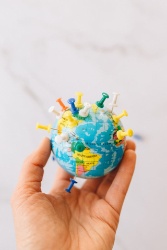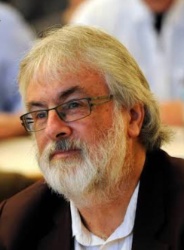Tattoos Help Identify Tsunami Victims' Bodies
Tsunami Report: Tattoos Help Identify Vicims' Bodies
By Richard S. Ehrlich
PHUKET, Thailand -- The popularity of tattoos among foreigners and Thais has helped identify bodies recovered from the tsunami, especially when it is difficult to match DNA with a relative, or find dental records, according to a U.S. government forensic anthropologist sorting the cadavers.
"Now that
they're more popular, I assume more people have more records
of their tattoos, and so it would be useful," said Paul D.
Emanovsky, a forensic anthropologist based at the Central
Identification Laboratory at Hickam Air Force Base in
Hawaii.
"I think it definitely helps. It is
definitely one of the things that could help lead to a
presumptive identification, that could then be further
checked," Mr. Emanovsky said in an interview.
"If
there are no family [DNA] reference samples that can ever be
obtained, and you can't ever find dental X-rays or dental
chart information, and if already the fingerprint is no
longer viable, in a specific case, then it would be very,
very difficult to identify that person.
"As long
as the ante-mortem [before death] records are gathered, I
think most cases have a very good chance of being
identified."
Other clues include "medical histories -- for instance if a person had broken their arm, or had surgical intervention, those are markers that could show up and help identify that person," he said.
Thai forensic officials are inserting computer chips into
corpses to assist with identification, Mr. Emanovsky said,
confirming sketchy Thai news reports about the high-tech
procedure.
"I have not actually seen it
implanted, but the Thais are putting some sort of chip into
the skull, to track the remains," Mr. Emanovsky said.
"What I've been told is, they're implanting it into the maxillary sinus," he said, indicating the upper jaw bone below the cheek.
Some DNA samples from corpses
retrieved from the tsunami will also be sent to Beijing,
China, for further testing.
"I believe some of
the DNA samples, post-mortem samples, are going to be
processed in a lab in Beijing," Mr. Emanovsky said.
Thailand's Prime Minister Thaksin Shinawatra also mentioned
the decision.
Labs in China could help match
names to corpses, especially among the estimated 2,000
bodies which remain unidentified, out of a total 5,291
people who died in Thailand's tsunamis.
"I have done the initial processing, or helped with the initial processing, of hundreds of bodies, at least a hundred," said Mr. Emanovsky, 28, whose hometown is Bohemia, Long Island, New York.
He described his work at Wat Yarn Yao,
a Buddhist temple which hurriedly constructed a morgue at
its site in Takua Pa district of tsunami-hit Phang Nga
province, just north of Phuket.
"I've been cutting -- some of the bodies are wrapped in sheets -- so I'll cut the sheets off, or wrappers, or I'll unzip the bag.
"Then I do a cursory physical examination of the
body at that moment, [and note] if the hair is long,
light-colored hair, or something along those lines," he
said.
"I describe the clothes that are on. Tag
the wrist with an identification number for the DVI
[Disaster Victim Identification] process, and then zip it
back up and put it in a new bag."
The sorted and
numbered bodies are then placed in containers for a more
detailed, post-mortem process.
"It is initiating
the system for identification," Mr. Emanovsky said of his
work. "It's definitely a sad, tragic event."
Mr.
Emanovsky is in Thailand with a team sent by the
Hawaii-based Joint POW/MIA Accounting Command (JPAC), which
usually seeks Americans missing from U.S. wars, or kept as
prisoners of war.
JPAC previously deployed Mr. Emanovsky to Laos, Vietnam, North Korea, Germany and Alaska to recover American bodies, he said.
"In those
cases, a lot of research and investigative work has gone
into where we are going to dig for remains, and where we are
looking for isolated burials, or aircraft crashes. So we
have investigative teams that have already gone out and
maybe found some wreckage, maybe found some life support.
"Then we go out and set up a full-scale recovery
on those, to excavate it, to crime scene archeological-type
standards, and maintain chain of custody and bring the
remains back to our lab in Hawaii," Mr. Emanovsky said.
Recovery and identification of Thailand's tsunami
victims is a very different mission.
"Here, most
of the collection work is happening by the [Thai] nationals,
who are bringing it to collection points. It is more of a
lab morgue operation, rather than a search and recovery
operation," for Mr. Emanovsky and other American JPAC teams,
he said.
When more than 4,000 bodies were
suddenly brought to the Buddhist temple shortly after the
tsunami on Dec. 26, hundreds of cadavers were put in shallow
graves which the Thais dug because they did not have enough
available refrigerated containers to preserve them for
detailed DNA tests.
"Some of them have been
exhumed," the forensic anthropologist said.
"I
think considering the circumstances, yes, it's fine," to
bury bodies which cannot be otherwise protected.
"Typically when a body is buried, it decomposes slower than
when it is on the surface because it has less access for
insects to invade, and less access for animals and whatnot
to help with the decomposition process."
Another
creative touch was the Thais' use of dry ice to help
preserve bodies outdoors at the temple.
"Yes,
there are bodies out in a field, or within the compound of
the wat [temple], that are packed in dry ice. Some of them
are outdoors.
"I've not seen it before," he said.
For Mr. Emanovsky, the forensic work has been
grueling but rewarding.
"I'm just glad that I can
be here, to lend some sort of assistance to helping the
identification process, and keeping the remains through a
chain of custody that will provide identifications down the
line," Mr. Emanovsky said.
"I enjoy all aspects of forensic anthropology, which includes mass disaster, and recent forensic cases, and forensic cases that JPAC typically works. I'm just interested in figuring out, and identifying, who people are from their remains, and what can be learned."
Richard S. Ehrlich, a freelance journalist who has reported news from Asia for the past 26 years, is co-author of the non-fiction book, "HELLO MY BIG BIG HONEY!" -- Love Letters to Bangkok Bar Girls and Their Revealing Interviews. His web page is http://www.geocities.com/glossograph/


 Martin LeFevre - Meditations: In A Global Society, There Is No Such Thing As “National Security”
Martin LeFevre - Meditations: In A Global Society, There Is No Such Thing As “National Security” Binoy Kampmark: Secrecy And Virtue Signalling - Another View Of Signalgate
Binoy Kampmark: Secrecy And Virtue Signalling - Another View Of Signalgate Gordon Campbell: On The Americanising Of NZ’s Public Health System
Gordon Campbell: On The Americanising Of NZ’s Public Health System Ian Powell: Trumpian Health Leadership
Ian Powell: Trumpian Health Leadership Eugene Doyle: Disruption - Historians Challenge Russophobic Propaganda
Eugene Doyle: Disruption - Historians Challenge Russophobic Propaganda Ramzy Baroud: War, Doublethink, And The Struggle For Survival - Geopolitics Of The Gaza Genocide
Ramzy Baroud: War, Doublethink, And The Struggle For Survival - Geopolitics Of The Gaza Genocide